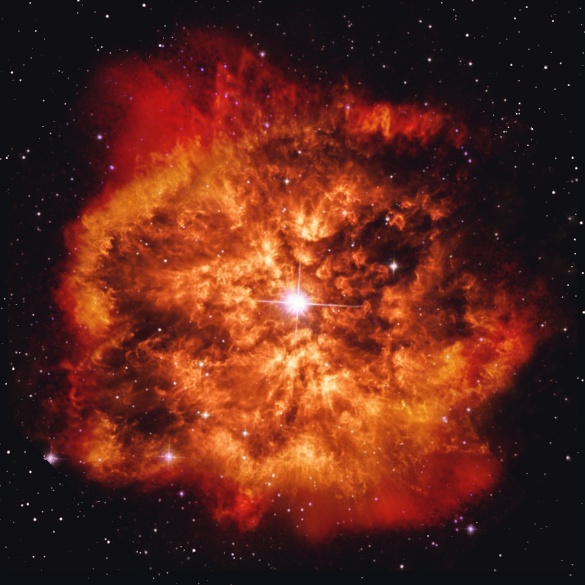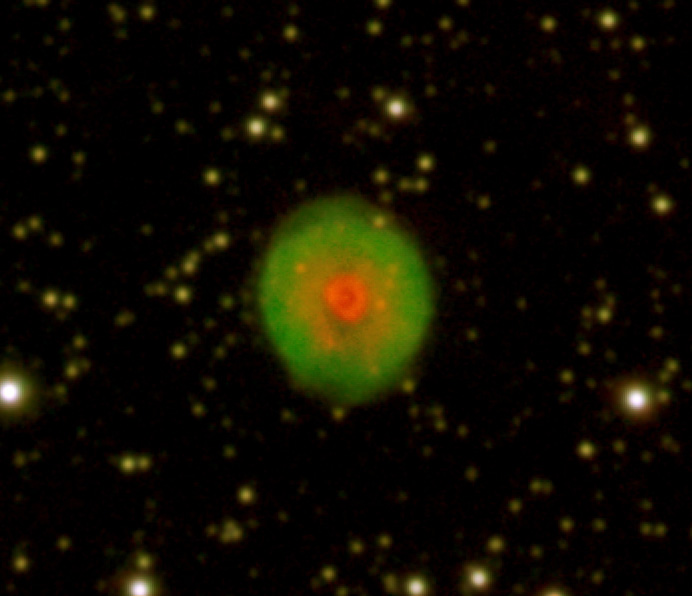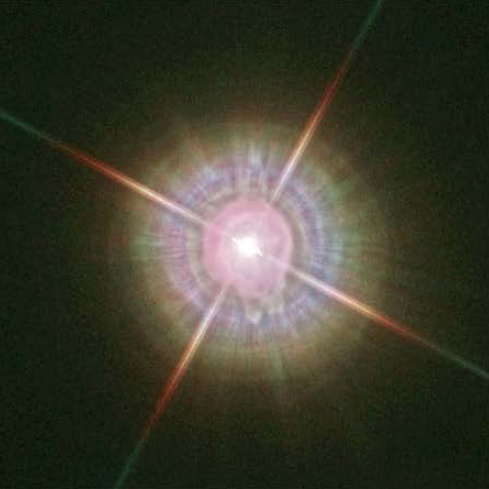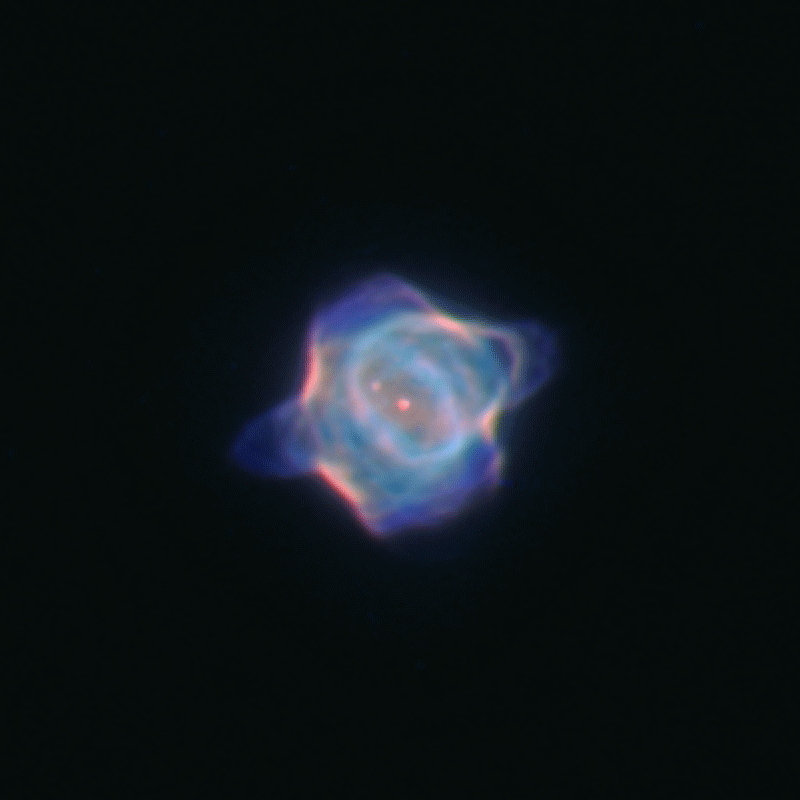NOVAE
 Novae are the result of the interaction of stars in close
binary systems, where a white dwarf (WD) accretes H rich
material from a companion, typically a giant or subgiant
low-mass star (Bode & Evans 2008). When the
accreted material reaches a critical mass, a thermonuclear
runaway (TNR) occurs.
Highly processed material is ejected at velocities ∼1000
km/s (Bode 2010) in a classical nova (CN) event. With
time, the nova remnants will expand and mix into the
interstellar medium (ISM).
The morphology and expansion of a nova remnant
depend on the details of the nova event, but also on
the interactions of the ejecta with the stellar companion
and the pre-existing circumstellar material, which may
consists of an accretion disk and a common envelope.
Novae are the result of the interaction of stars in close
binary systems, where a white dwarf (WD) accretes H rich
material from a companion, typically a giant or subgiant
low-mass star (Bode & Evans 2008). When the
accreted material reaches a critical mass, a thermonuclear
runaway (TNR) occurs.
Highly processed material is ejected at velocities ∼1000
km/s (Bode 2010) in a classical nova (CN) event. With
time, the nova remnants will expand and mix into the
interstellar medium (ISM).
The morphology and expansion of a nova remnant
depend on the details of the nova event, but also on
the interactions of the ejecta with the stellar companion
and the pre-existing circumstellar material, which may
consists of an accretion disk and a common envelope.
DYNAMICS
 The expansion and dispersal of nova shells reveal details of the nova ejection and give insights into the plasma physics and shock phenomena associated with the blast produced by the interaction of H-poor, metal-rich ejecta with the circumstellar environment. Moreover, the fast expansion of novae allows the study of their full dynamical evolution on timescales comparable with human lifetimes.
Multi-epoch images and high-dispersion spectroscopic observations of some classical nova shell
around nova-like systems can be used to derive expansion rates and expansion velocities.
The expansion and dispersal of nova shells reveal details of the nova ejection and give insights into the plasma physics and shock phenomena associated with the blast produced by the interaction of H-poor, metal-rich ejecta with the circumstellar environment. Moreover, the fast expansion of novae allows the study of their full dynamical evolution on timescales comparable with human lifetimes.
Multi-epoch images and high-dispersion spectroscopic observations of some classical nova shell
around nova-like systems can be used to derive expansion rates and expansion velocities.
More info
- Novae here
- Animations here
WOLF-RAYET
WOLF-RAYET NEBULAE
 Massive stars are the main actors shaping and stirring the ISM. They destroy their natal molecular clouds by a combination of their powerful UV fluxes and stellar winds creating the largest cavities in the ISM. In particular, very massive stars (M > 30 M๏) will evolve through a phase of strong mass-loss rate and slow wind, a red supergiant (RSG) or luminous blue variable (LBV) phase. After expelling most of their outer hydrogen-rich envelopes, the core is exposed becoming a Wolf-Rayet (WR) star. WR stars exhibit the strongest stellar winds of all stars, which interacts with the material previously ejected compressing it whilst the central star ionizes it. This creates the so-called WR nebulae. The wind-wind interaction produces an adiabatically-shocked region that reaches temperatures of millions of degrees. This hot bubble is surrounded by an optical nebula that is rich in dust and complex molecules formed in the previous evolutionary phase (RSG or LBV). Thus, multi wavelength studies of WR nebulae are most needed in order to unveil the variety of complexes processes acting in the vicinity of the most powerful sources of kinetic energy in the ISM.
Massive stars are the main actors shaping and stirring the ISM. They destroy their natal molecular clouds by a combination of their powerful UV fluxes and stellar winds creating the largest cavities in the ISM. In particular, very massive stars (M > 30 M๏) will evolve through a phase of strong mass-loss rate and slow wind, a red supergiant (RSG) or luminous blue variable (LBV) phase. After expelling most of their outer hydrogen-rich envelopes, the core is exposed becoming a Wolf-Rayet (WR) star. WR stars exhibit the strongest stellar winds of all stars, which interacts with the material previously ejected compressing it whilst the central star ionizes it. This creates the so-called WR nebulae. The wind-wind interaction produces an adiabatically-shocked region that reaches temperatures of millions of degrees. This hot bubble is surrounded by an optical nebula that is rich in dust and complex molecules formed in the previous evolutionary phase (RSG or LBV). Thus, multi wavelength studies of WR nebulae are most needed in order to unveil the variety of complexes processes acting in the vicinity of the most powerful sources of kinetic energy in the ISM.
WOLF-RAYET STARS
 The Wolf-Rayet phenomenon occurs in massive and low-mass stars. Those stars classified as the Wolf-Rayet-type exhibit the strongest and fastest stellar winds in the universe reaching velocities as high as 4000 km/s. This fast wind interacts with the circumstellar material compressing it producing nebulae. Understanding the stellar
feedback requires detailed treatment of state-of-the-art stellar atmosphere's code in
combination with multi-wavelength spectroscopic analysis.
The Wolf-Rayet phenomenon occurs in massive and low-mass stars. Those stars classified as the Wolf-Rayet-type exhibit the strongest and fastest stellar winds in the universe reaching velocities as high as 4000 km/s. This fast wind interacts with the circumstellar material compressing it producing nebulae. Understanding the stellar
feedback requires detailed treatment of state-of-the-art stellar atmosphere's code in
combination with multi-wavelength spectroscopic analysis.
More info
-Wolf-Rayet nebulae here
-Wolf-Rayet stars here
 Low-to-intermediate mass (1-8 M๏) stars, after having exhausted hydrogen and helium as nuclear combustibles at their cores, ascend the asymptotic giant branch (AGB). At the tip of the AGB, these stars suffer heavy mass loss episodes and eject their envelopes, while the stellar remanent increases steadily its effective temperature. At the time the central star becomes hot enough to ionize the circumstellar envelope (Teff ≥ 25 000 K), a planetary nebula (PN) arises.
PNe display an enormous variety of shapes and structural components at different spatial scales, from small-scale knots, filaments and jets to large-scale rims, shells and haloes. The general PN morphologies, i.e., round, elliptical, and bipolar, are interpreted in the framework of the interaction between the fast and tenuous post-AGB stelar wind with the slow and dense AGB wind, but small-scale structures are difficult to understand.
Low-to-intermediate mass (1-8 M๏) stars, after having exhausted hydrogen and helium as nuclear combustibles at their cores, ascend the asymptotic giant branch (AGB). At the tip of the AGB, these stars suffer heavy mass loss episodes and eject their envelopes, while the stellar remanent increases steadily its effective temperature. At the time the central star becomes hot enough to ionize the circumstellar envelope (Teff ≥ 25 000 K), a planetary nebula (PN) arises.
PNe display an enormous variety of shapes and structural components at different spatial scales, from small-scale knots, filaments and jets to large-scale rims, shells and haloes. The general PN morphologies, i.e., round, elliptical, and bipolar, are interpreted in the framework of the interaction between the fast and tenuous post-AGB stelar wind with the slow and dense AGB wind, but small-scale structures are difficult to understand.
 In a few cases, a very late thermal pulse (VLTP) can occur when the central star of the PN is descending the white dwarf cooling track. During this explosive event, which can be described as a scaled-down nova-like explosion, the star ejects hydrogen-deficient, carbon-rich material inside the old PN, creating a born-again PN. Our team has recently added two new members, namely HuBi 1 and NGC 40, to the exclusive class of born-again PNe: A 30, A 58, A 78, and Sakurai's object.
The born-again ejecta is not isotropic, but material is ejected into a disk and a fast bipolar ejection. The interactions of the born-again ejecta with the old nebular material and new fast stellar wind result in rich and complex hydrodynamical processes that can be followed on timescales comparable to human lifetimes.
In a few cases, a very late thermal pulse (VLTP) can occur when the central star of the PN is descending the white dwarf cooling track. During this explosive event, which can be described as a scaled-down nova-like explosion, the star ejects hydrogen-deficient, carbon-rich material inside the old PN, creating a born-again PN. Our team has recently added two new members, namely HuBi 1 and NGC 40, to the exclusive class of born-again PNe: A 30, A 58, A 78, and Sakurai's object.
The born-again ejecta is not isotropic, but material is ejected into a disk and a fast bipolar ejection. The interactions of the born-again ejecta with the old nebular material and new fast stellar wind result in rich and complex hydrodynamical processes that can be followed on timescales comparable to human lifetimes.
 A fraction of nebulae around evolved low-to-intermediate-mass stars are characterized by external structures such as haloes, arcs, rings, and spiral patterns. The formation of the aforementioned features is connected with the last gasps of mass-loss during the late evolutionary stages of these stars. These structure encode critical information to understand these stages of stellar evolution. Indeed, the haloes, elusive low-surface brigthness roundish shells, are considered to be the relic of the last AGB mass loss episode, whereas arcs, rings, and spiral patterns may be connected to the evolution of the central star in a binary system.
A fraction of nebulae around evolved low-to-intermediate-mass stars are characterized by external structures such as haloes, arcs, rings, and spiral patterns. The formation of the aforementioned features is connected with the last gasps of mass-loss during the late evolutionary stages of these stars. These structure encode critical information to understand these stages of stellar evolution. Indeed, the haloes, elusive low-surface brigthness roundish shells, are considered to be the relic of the last AGB mass loss episode, whereas arcs, rings, and spiral patterns may be connected to the evolution of the central star in a binary system.
 The ionized component of the optically brightest regions of a PN is actually a small fraction (0.1-0.2 M๏) of the total mass ejected to the ISM by low-to-intermediate-mass stars. The outermost faintest and/or coldest shells of a PN comprise a large fraction of the yield of a PN to the ISM and give important insights on advances stages of dilution of nebular material into the ISM.
The ionized component of the optically brightest regions of a PN is actually a small fraction (0.1-0.2 M๏) of the total mass ejected to the ISM by low-to-intermediate-mass stars. The outermost faintest and/or coldest shells of a PN comprise a large fraction of the yield of a PN to the ISM and give important insights on advances stages of dilution of nebular material into the ISM.
 Novae are the result of the interaction of stars in close
binary systems, where a white dwarf (WD) accretes H rich
material from a companion, typically a giant or subgiant
low-mass star (Bode & Evans 2008). When the
accreted material reaches a critical mass, a thermonuclear
runaway (TNR) occurs.
Highly processed material is ejected at velocities ∼1000
km/s (Bode 2010) in a classical nova (CN) event. With
time, the nova remnants will expand and mix into the
interstellar medium (ISM).
The morphology and expansion of a nova remnant
depend on the details of the nova event, but also on
the interactions of the ejecta with the stellar companion
and the pre-existing circumstellar material, which may
consists of an accretion disk and a common envelope.
Novae are the result of the interaction of stars in close
binary systems, where a white dwarf (WD) accretes H rich
material from a companion, typically a giant or subgiant
low-mass star (Bode & Evans 2008). When the
accreted material reaches a critical mass, a thermonuclear
runaway (TNR) occurs.
Highly processed material is ejected at velocities ∼1000
km/s (Bode 2010) in a classical nova (CN) event. With
time, the nova remnants will expand and mix into the
interstellar medium (ISM).
The morphology and expansion of a nova remnant
depend on the details of the nova event, but also on
the interactions of the ejecta with the stellar companion
and the pre-existing circumstellar material, which may
consists of an accretion disk and a common envelope.
 The expansion and dispersal of nova shells reveal details of the nova ejection and give insights into the plasma physics and shock phenomena associated with the blast produced by the interaction of H-poor, metal-rich ejecta with the circumstellar environment. Moreover, the fast expansion of novae allows the study of their full dynamical evolution on timescales comparable with human lifetimes.
Multi-epoch images and high-dispersion spectroscopic observations of some classical nova shell
around nova-like systems can be used to derive expansion rates and expansion velocities.
The expansion and dispersal of nova shells reveal details of the nova ejection and give insights into the plasma physics and shock phenomena associated with the blast produced by the interaction of H-poor, metal-rich ejecta with the circumstellar environment. Moreover, the fast expansion of novae allows the study of their full dynamical evolution on timescales comparable with human lifetimes.
Multi-epoch images and high-dispersion spectroscopic observations of some classical nova shell
around nova-like systems can be used to derive expansion rates and expansion velocities.
 Massive stars are the main actors shaping and stirring the ISM. They destroy their natal molecular clouds by a combination of their powerful UV fluxes and stellar winds creating the largest cavities in the ISM. In particular, very massive stars (M > 30 M๏) will evolve through a phase of strong mass-loss rate and slow wind, a red supergiant (RSG) or luminous blue variable (LBV) phase. After expelling most of their outer hydrogen-rich envelopes, the core is exposed becoming a Wolf-Rayet (WR) star. WR stars exhibit the strongest stellar winds of all stars, which interacts with the material previously ejected compressing it whilst the central star ionizes it. This creates the so-called WR nebulae. The wind-wind interaction produces an adiabatically-shocked region that reaches temperatures of millions of degrees. This hot bubble is surrounded by an optical nebula that is rich in dust and complex molecules formed in the previous evolutionary phase (RSG or LBV). Thus, multi wavelength studies of WR nebulae are most needed in order to unveil the variety of complexes processes acting in the vicinity of the most powerful sources of kinetic energy in the ISM.
Massive stars are the main actors shaping and stirring the ISM. They destroy their natal molecular clouds by a combination of their powerful UV fluxes and stellar winds creating the largest cavities in the ISM. In particular, very massive stars (M > 30 M๏) will evolve through a phase of strong mass-loss rate and slow wind, a red supergiant (RSG) or luminous blue variable (LBV) phase. After expelling most of their outer hydrogen-rich envelopes, the core is exposed becoming a Wolf-Rayet (WR) star. WR stars exhibit the strongest stellar winds of all stars, which interacts with the material previously ejected compressing it whilst the central star ionizes it. This creates the so-called WR nebulae. The wind-wind interaction produces an adiabatically-shocked region that reaches temperatures of millions of degrees. This hot bubble is surrounded by an optical nebula that is rich in dust and complex molecules formed in the previous evolutionary phase (RSG or LBV). Thus, multi wavelength studies of WR nebulae are most needed in order to unveil the variety of complexes processes acting in the vicinity of the most powerful sources of kinetic energy in the ISM.
 The Wolf-Rayet phenomenon occurs in massive and low-mass stars. Those stars classified as the Wolf-Rayet-type exhibit the strongest and fastest stellar winds in the universe reaching velocities as high as 4000 km/s. This fast wind interacts with the circumstellar material compressing it producing nebulae. Understanding the stellar
feedback requires detailed treatment of state-of-the-art stellar atmosphere's code in
combination with multi-wavelength spectroscopic analysis.
The Wolf-Rayet phenomenon occurs in massive and low-mass stars. Those stars classified as the Wolf-Rayet-type exhibit the strongest and fastest stellar winds in the universe reaching velocities as high as 4000 km/s. This fast wind interacts with the circumstellar material compressing it producing nebulae. Understanding the stellar
feedback requires detailed treatment of state-of-the-art stellar atmosphere's code in
combination with multi-wavelength spectroscopic analysis.